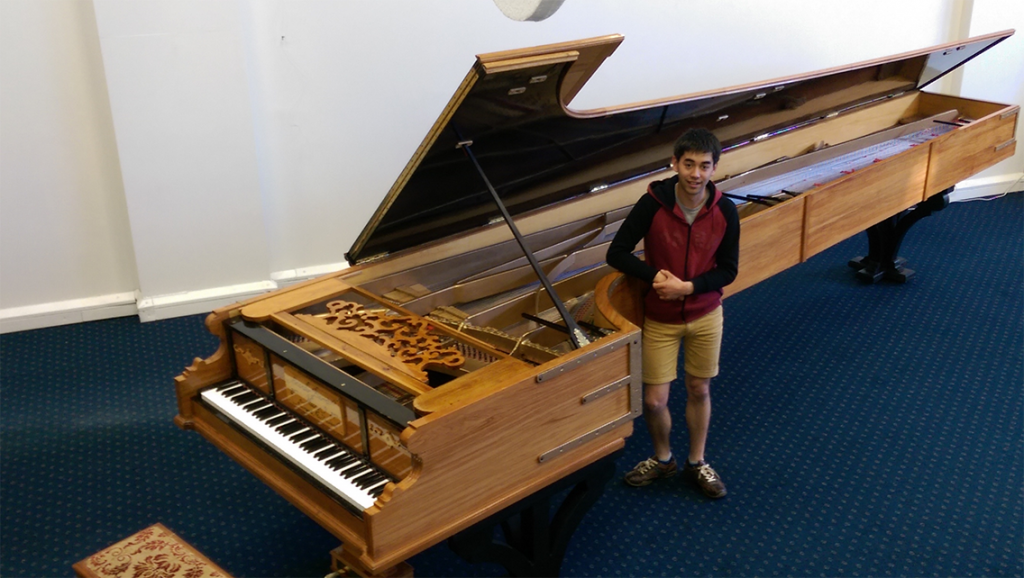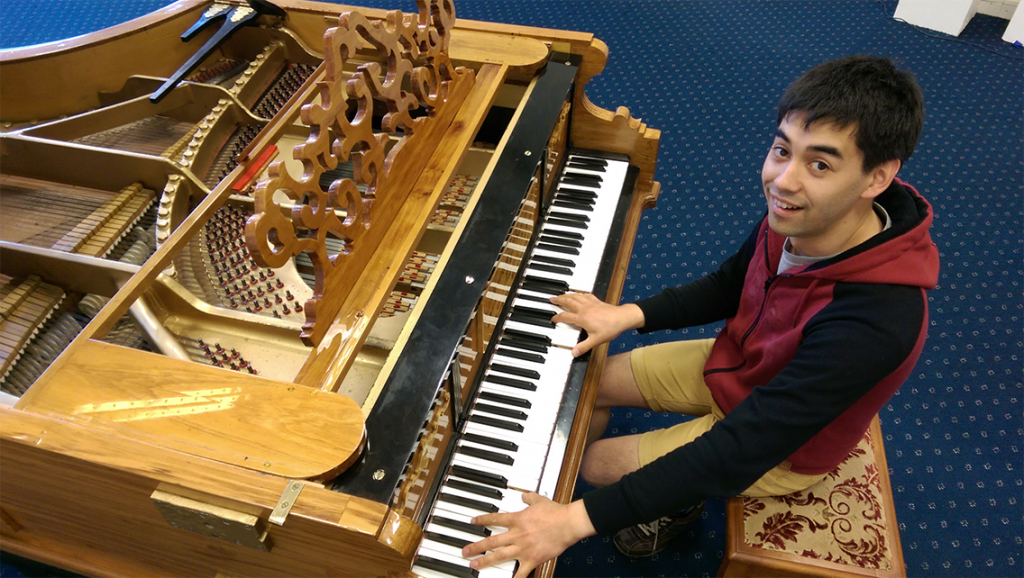Perseverance plays off for the piano Mann
Young piano builder Adrian Mann has been kept busy entertaining Creative Waikato visitors fascinated by his creation – the largest piano in the world. He talks tonight at Creative Waikato, Alexandra Street.
“Ambitious.â€
That’s about as much as some people would say to Adrian Mann’s face when he’d tell them he was building a piano.
He could tell they were thinking, “It ain’t gonna happen, mate. You’ll never finish it.â€

But he did.
He built a piano.
He built the longest piano in the world.
From front to back, it measures over five point seven metres.
Its front looks similar to many of the small upright pianos of yesteryear, including just 85 keys, and a name.
Adrian says he named the piano after his “mother’s father’s grandfatherâ€, Alexander Barrie Mann, the first of Adrian’s ancestors to bring the name “Mann†to New Zealand.
The piano’s shape, as seen from above, is like what a limousine is to a sedan, with the ratio of the length of the high note wires to the length of the low note wires being smaller than the ratio seen in normal grands.
Adrian says the high note wires had to be as short as they are, because there is not a piano string in existence that is sufficiently tensile and sufficiently flexible to allow for longer strings to be used for the highest notes. They have to be about as short as they are because if they were longer, in order for them to vibrate quickly enough to create the high notes, the strings would have to be pulled so taut they would break. For that reason, the length of the shortest strings in all pianos is standard: between 50mm and 60mm.
Adrian says the unfamiliar shape of his piano is not due to how short the short part of the piano is, but about how long the long part of the piano is.
In normal pianos, the longer strings have copper wire wound around them in order to increase their mass. The increased mass results in the strings vibrating at lower frequencies per second (Hertz) than unwound strings of the same length. The pianos are then able to produce low tones while using relatively short strings.
However, as well as lowering a string’s natural Hertz, the copper changes what one of Adrian’s mentors calls “inharmonisityâ€. Inharmonisity is heard as less clarity.
A visual equivalent of copper’s presence on piano strings is the suspension of reflective particles in otherwise clear spring water through which light is shone. Without particulates disrupting photonic flow, light can be seen more clearly. In a similar way, without copper slowing strings, their sound is uncluttered and clean.
In order to achieve lower tones in the Alexander, longer and longer string lengths are used, based on a logarithmic scale. Whereas most piano cases restrict how long the longest strings can reach before the introduction of copper is needed, the Alexander’s frame and wooden case are so long that even the longest bass strings ring copper-free clear.
As well as the strings, other parts of the piano contribute to the sounds it projects.
The piano has at least 30 tree species in its composition, including rimu, kauri, jarrah, various pine, and cedar. An Indonesian hard wood was the most difficult to plane, says Adrian.
“You have to have your planes really sharp to be able to plane it properly.â€
It was Adrian’s sharp and inquisitive mind that paved the path to the piano’s planing.
What began as a question—“How long would a piano’s base string be if it didn’t have copper wire round around it?â€â€”transitioned into a rudimentary experiment to ascertain the answer.
Adrian whacked a couple of “Warratah†steel fence posts into the ground, one about six metres away from the other. Between them he threaded a six-metre long strand of wire normally used for ships’ cabling. He tightened the wire until it was taut, and then hit it.
Adrian heard a sound that resonated deep within him.
The sound surprised him.
It piqued his interest, and he was hooked.
Deep calls unto deep. The struck wire emitted a low toned note with a timbre he wanted to replicate — in a piano.
And so it began: He’d been set on a path from which he wavered not.
Over the four years it took to build the Alexander, there were set backs Adrian describes as being like three steps forward to one step back, and there was no shortage of naysayers.

“There would be piano tuners that would come up to us and say, ‘This is impossible. You can’t do this. This will not work. No. People have tried, and it doesn’t work, so why are you trying? It’s impossible. You can’t do it.’
“So I got sick of hearing all that, because I knew I could do it.â€
Adrian persevered.
He received encouragement and practical input from visionary supporters, including a royally declared ‘Lady’ who’s well known in Timaru for large scale projects of her own.
To maintain self-motivation in his piano building project, Adrian set up another long piece of wire in his working environment.
Hammering that wire was the way he would remember what he was working to achieve. It was hammering a long wire that first inspired the creation of the piano, and every time it gave its sound, Adrian was compelled to continue.
“Oh, I’ve got to get that sound. I’ve got to continue.â€
Some people look at “dream†photos stuck to their fridge; Adrian had his wire.
And now he has a piano.
Touring busloads of people visit the piano at its usual home near Timaru, but with support from numerous organisations and individuals, including Wintec’s Cate Prestidge, Adrian brought the Alexander for a trip to the North Island.
Adrian, who spoke at a Youth TEDx event in 2013, continues to give presentations about his project, keeps the piano tuned, and allows members of the public to play it and to attend performances by a variety of competent pianists.
Creative Waikato hosted the instrument in their Hamilton based headquarters for some of October, before the masterpiece headed back down to Timaru en route to Invercargill in November.




